Page 124 of 352
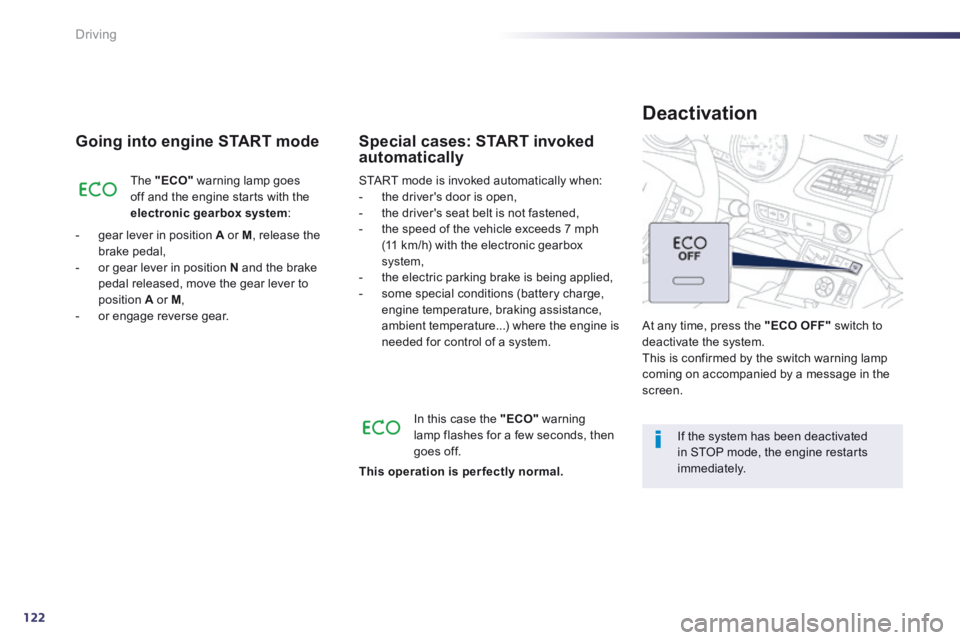
122
Driving
Going into engine START mode
The "ECO" warning lamp goes off and the engine starts with the electronic gearbox system :
- gear lever in position A or M , release the brake pedal, - or gear lever in position N and the brake pedal released, move the gear lever to position A or M , - or engage reverse gear.
START mode is invoked automatically when: - the driver's door is open, - the driver's seat belt is not fastened, - the speed of the vehicle exceeds 7 mph (11 km/h) with the electronic gearbox system, - the electric parking brake is being applied, - some special conditions (battery charge, engine temperature, braking assistance, ambient temperature...) where the engine is needed for control of a system.
Special cases: START invoked automatically
In this case the "ECO" warning
lamp flashes for a few seconds, then goes off. If the system has been deactivated in STOP mode, the engine restarts immediately.
At any time, press the "ECO OFF" switch to deactivate the system. This is confirmed by the switch warning lamp coming on accompanied by a message in the screen.
Deactivation
This operation is perfectly normal.
Page 125 of 352
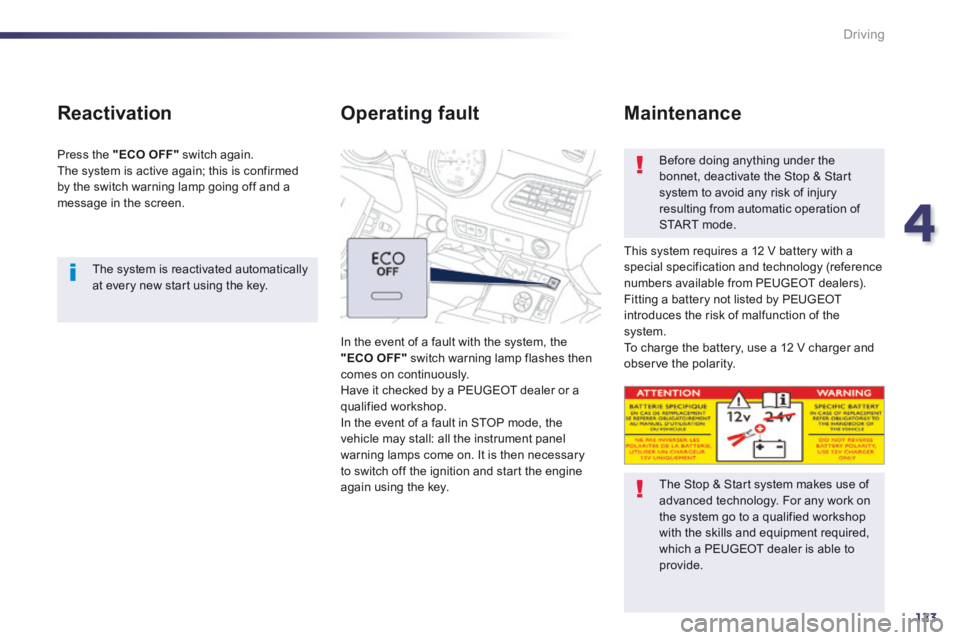
4
123
Driving
The system is reactivated automatically at every new start using the key.
Reactivation
Press the "ECO OFF" switch again. The system is active again; this is confirmed by the switch warning lamp going off and a message in the screen.
Operating fault
In the event of a fault with the system, the "ECO OFF" switch warning lamp flashes then comes on continuously. Have it checked by a PEUGEOT dealer or a qualified workshop. In the event of a fault in STOP mode, the
vehicle may stall: all the instrument panel warning lamps come on. It is then necessary to switch off the ignition and start the engine again using the key.
Before doing anything under the bonnet, deactivate the Stop & Start system to avoid any risk of injury resulting from automatic operation of START mode.
This system requires a 12 V battery with a special specification and technology (reference numbers available from PEUGEOT dealers). Fitting a battery not listed by PEUGEOT introduces the risk of malfunction of the system. To charge the battery, use a 12 V charger and observe the polarity.
Maintenance
The Stop & Start system makes use of advanced technology. For any work on the system go to a qualified workshop with the skills and equipment required, which a PEUGEOT dealer is able to provide.
Page 126 of 352
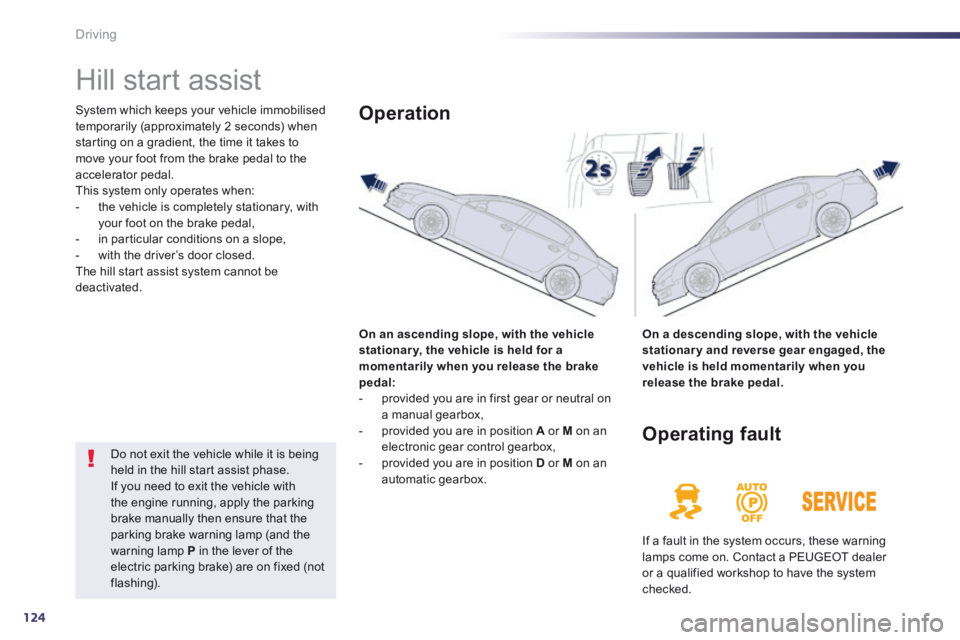
124
Driving
Hill start assist
System which keeps your vehicle immobilised temporarily (approximately 2 seconds) when starting on a gradient, the time it takes to move your foot from the brake pedal to the accelerator pedal. This system only operates when: - the vehicle is completely stationary, with your foot on the brake pedal, - in particular conditions on a slope, - with the driver’s door closed. The hill start assist system cannot be deactivated.
On an ascending slope, with the vehicle stationar y, the vehicle is held for a momentarily when you release the brake pedal: - provided you are in first gear or neutral on a manual gearbox,
- provided you are in position A or M on an electronic gear control gearbox, - provided you are in position D or M on an automatic gearbox.
Operation
On a descending slope, with the vehicle stationary and reverse gear engaged, the vehicle is held momentarily when you release the brake pedal.
Do not exit the vehicle while it is being held in the hill start assist phase. If you need to exit the vehicle with the engine running, apply the parking brake manually then ensure that the
parking brake warning lamp (and the warning lamp P in the lever of the electric parking brake) are on fixed (not flashing).
Operating fault
If a fault in the system occurs, these warning lamps come on. Contact a PEUGEOT dealer or a qualified workshop to have the system checked.
Page 127 of 352
4
125
Driving
Head-up display
System which projects various information onto a smoked strip in the field of vision of the driver so that they do not have to take their eyes off the road.
1. Head-up display on. 2. Head-up display off (long press). 3. Brightness adjustment. 4. Display height adjustment.
Buttons
Once the system has been activated, the following information is grouped together in the head-up display: A. The speed of your vehicle. B. Cruise control/speed limiter information.
Displays during operation
C. Navigation information (according to ve r s i o n).
For more information on the navigation system, refer to the "Audio and telematic" section.
This system operates when the engine is running and the settings are stored when the ignition is switched off.
Page 128 of 352
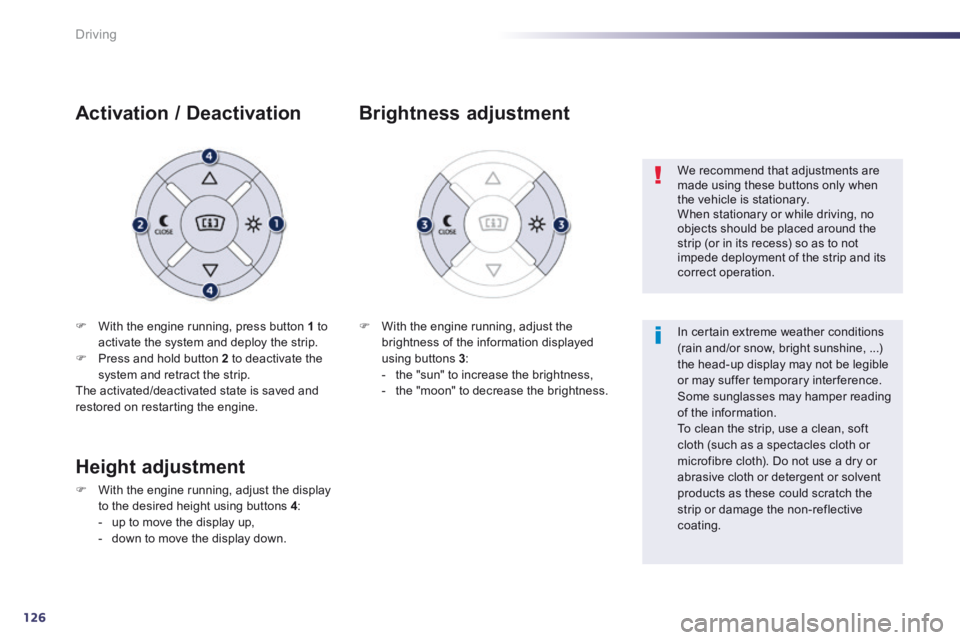
126
Driving
With the engine running, press button 1 to activate the system and deploy the strip. Press and hold button 2 to deactivate the system and retract the strip. The activated/deactivated state is saved and restored on restarting the engine.
Activation / Deactivation
With the engine running, adjust the brightness of the information displayed using buttons 3 : - the "sun" to increase the brightness, - the "moon" to decrease the brightness.
Brightness adjustment
We recommend that adjustments are made using these buttons only when the vehicle is stationary. When stationary or while driving, no objects should be placed around the strip (or in its recess) so as to not impede deployment of the strip and its correct operation.
In certain extreme weather conditions (rain and/or snow, bright sunshine, ...) the head-up display may not be legible or may suffer temporary interference. Some sunglasses may hamper reading of the information. To clean the strip, use a clean, soft
cloth (such as a spectacles cloth or microfibre cloth). Do not use a dry or abrasive cloth or detergent or solvent products as these could scratch the strip or damage the non-reflective coating.
Height adjustment
With the engine running, adjust the display to the desired height using buttons 4 : - up to move the display up,
- down to move the display down.
Page 141 of 352
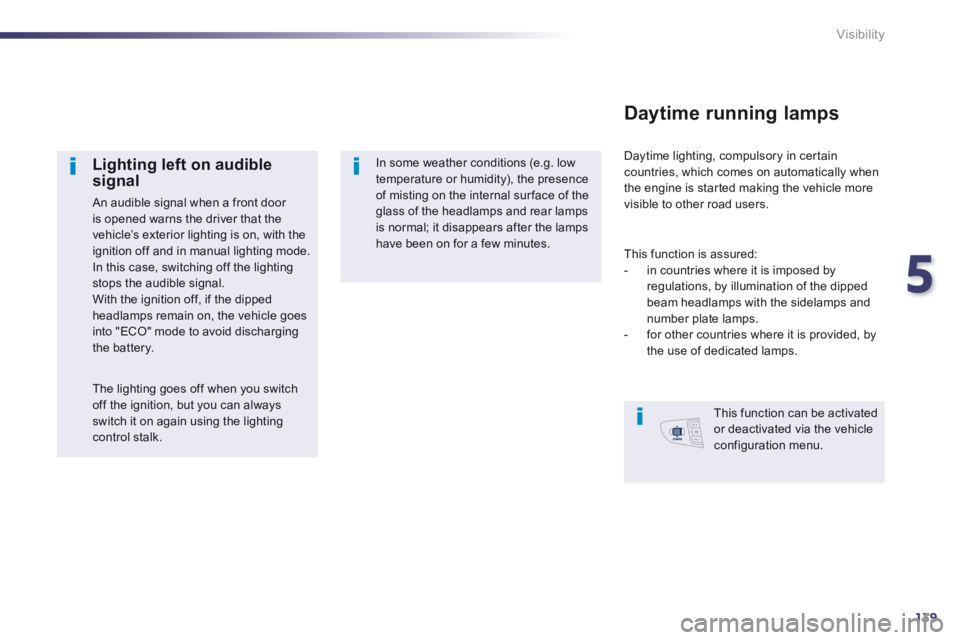
5
139
Visibility
Lighting left on audible signal
An audible signal when a front door is opened warns the driver that the vehicle’s exterior lighting is on, with the ignition off and in manual lighting mode. In this case, switching off the lighting stops the audible signal. With the ignition off, if the dipped headlamps remain on, the vehicle goes into "ECO" mode to avoid discharging the battery.
In some weather conditions (e.g. low temperature or humidity), the presence of misting on the internal sur face of the glass of the headlamps and rear lamps is normal; it disappears after the lamps have been on for a few minutes.
Daytime lighting, compulsory in certain countries, which comes on automatically when the engine is started making the vehicle more visible to other road users.
Daytime running lamps
This function is assured: - in countries where it is imposed by regulations, by illumination of the dipped beam headlamps with the sidelamps and number plate lamps. - for other countries where it is provided, by the use of dedicated lamps.
This function can be activated or deactivated via the vehicle configuration menu.
The lighting goes off when you switch off the ignition, but you can always switch it on again using the lighting control stalk.
Page 153 of 352
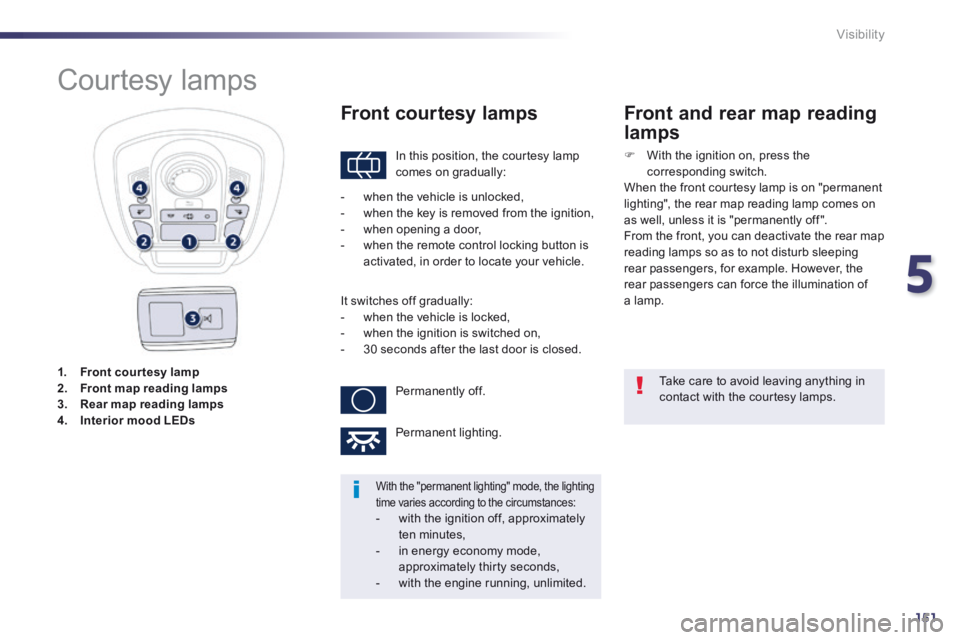
5
151
Visibility
1. Front courtesy lamp2. Front map reading lamp s3. Rear map reading lamps4. Interior mood LEDs
Courtesy lamps
In this position, the courtesy lamp comes on gradually:
Front courtesy lamps
Take care to avoid leaving anything in contact with the courtesy lamps.
With the "permanent lighting" mode, the lighting time varies according to the circumstances: - with the ignition off, approximately ten minutes, - in energy economy mode, approximately thirty seconds, - with the engine running, unlimited.
- when the vehicle is unlocked, - when the key is removed from the ignition, - when opening a door, - when the remote control locking button is activated, in order to locate your vehicle.
It switches off gradually: - when the vehicle is locked, - when the ignition is switched on, - 30 seconds after the last door is closed.
Permanently off.
Permanent lighting.
Front and rear map reading
lamps
With the ignition on, press the corresponding switch. When the front courtesy lamp is on "permanent lighting", the rear map reading lamp comes on as well, unless it is "permanently off ".
From the front, you can deactivate the rear map reading lamps so as to not disturb sleeping rear passengers, for example. However, the rear passengers can force the illumination of a lamp.
Page 171 of 352
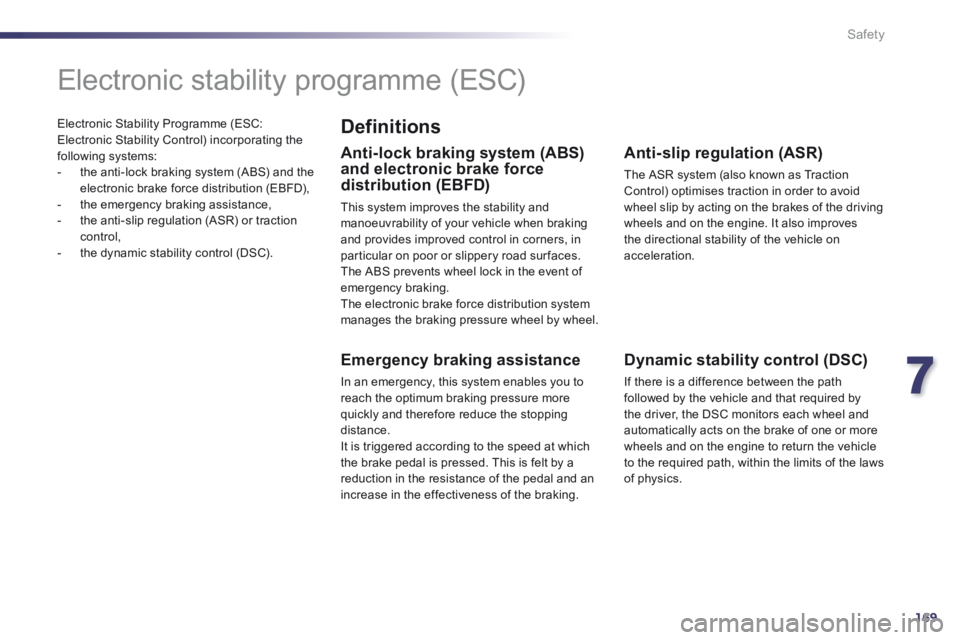
7
169
Safety
Electronic Stability Programme (ESC: Electronic Stability Control) incorporating the following systems: - the anti-lock braking system (ABS) and the electronic brake force distribution (EBFD), - the emergency braking assistance, - the anti-slip regulation (ASR) or traction control, - the dynamic stability control (DSC).
Electronic stability programme (ESC)
Definitions
Anti-lock braking system (ABS) and electronic brake force distribution (EBFD)
This system improves the stability and manoeuvrability of your vehicle when braking and provides improved control in corners, in particular on poor or slippery road sur faces. The ABS prevents wheel lock in the event of emergency braking. The electronic brake force distribution system manages the braking pressure wheel by wheel.
Emergency braking assistance
In an emergency, this system enables you to reach the optimum braking pressure more quickly and therefore reduce the stopping distance. It is triggered according to the speed at which the brake pedal is pressed. This is felt by a reduction in the resistance of the pedal and an increase in the effectiveness of the braking.
Anti-slip regulation (ASR)
The ASR system (also known as Traction Control) optimises traction in order to avoid wheel slip by acting on the brakes of the driving wheels and on the engine. It also improves the directional stability of the vehicle on acceleration.
Dynamic stability control (DSC)
If there is a difference between the path followed by the vehicle and that required by the driver, the DSC monitors each wheel and automatically acts on the brake of one or more wheels and on the engine to return the vehicle to the required path, within the limits of the laws of physics.